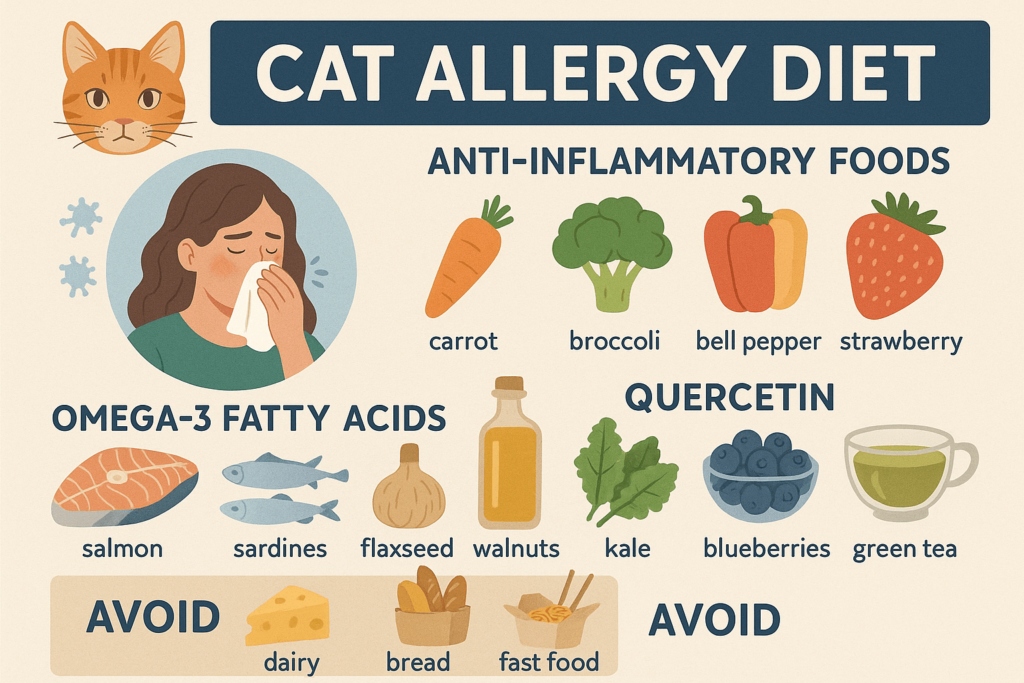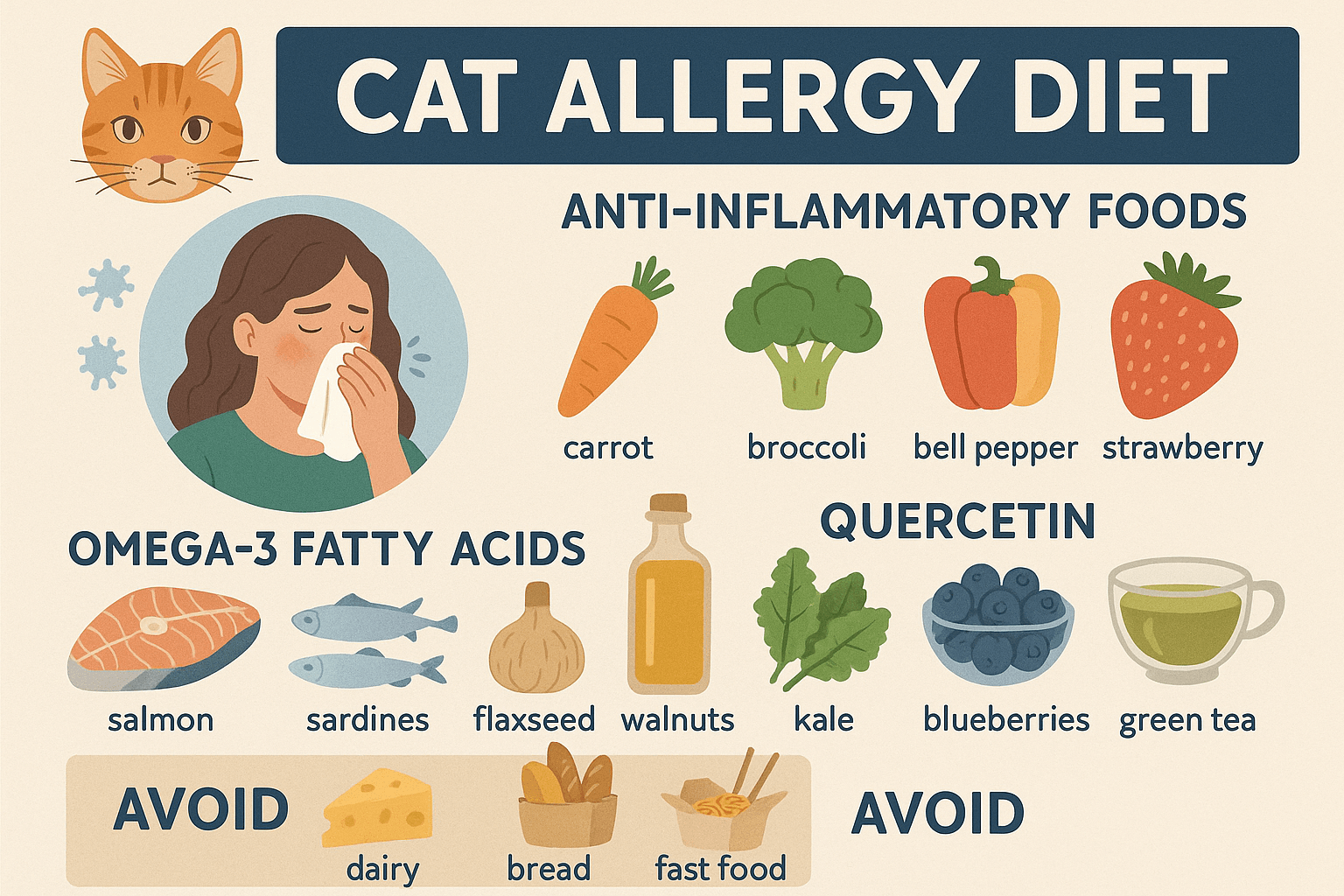Cat Allergy Diet: Managing Food Sensitivities in Felines
Food allergies in cats are more common than many pet owners realize, often manifesting as skin irritations, digestive issues, or chronic discomfort. A cat allergy diet is a tailored nutritional approach designed to identify and eliminate allergens from your feline’s meals, helping them regain their health and vitality. Whether you suspect your cat has a food allergy or simply want to learn how to prevent one, understanding the role of diet in managing sensitivities is crucial. This guide will walk you through everything you need to know about crafting a safe and effective allergy-friendly diet for your beloved pet.
Expert Insight on Cat Food Allergies
“Food allergies are rare in cats. It is estimated that just 1% of all cats have food allergies, and up to 15% of itchy cats. Of cats with both itching and gastrointestinal symptoms, up to 42% could be food-allergic. A relationship to age, gender, or breed has not been identified.”
Common Signs Your Cat May Have a Food Allergy
Identifying a food allergy in cats can be challenging, as symptoms often overlap with other health conditions. Recognizing these signs early is the first step toward addressing the issue effectively.
Itchy Skin and Excessive Grooming:
Cats with food allergies frequently experience intense itching, leading to over-grooming and hair loss.Chronic Ear Infections:
Persistent ear problems, such as redness, swelling, or discharge, may indicate an underlying food sensitivity.Gastrointestinal Issues:
Vomiting, diarrhea, or frequent loose stools can signal that your cat’s digestive system is reacting poorly to certain ingredients.Red or Inflamed Paws:
Swollen or irritated paws are a common symptom of allergic reactions in cats.Unexplained Weight Loss:
If your cat is losing weight despite eating normally, it could be due to an intolerance to specific foods.
By observing these symptoms closely, you can work with your veterinarian to determine whether a food allergy is the root cause and begin implementing dietary changes.

How to Transition to a Cat Allergy Diet Safely
Switching your cat to an allergy-friendly diet requires careful planning and gradual adjustments to avoid upsetting their digestive system. Follow these steps to ensure a smooth transition.
Consult Your Veterinarian First:
Before making any dietary changes, seek professional advice to confirm the diagnosis and receive tailored recommendations.Choose a Limited Ingredient Diet (LID):
LIDs contain fewer ingredients, reducing the likelihood of triggering an allergic reaction while helping identify the offending allergen.Introduce Novel Proteins:
Opt for proteins your cat hasn’t been exposed to before, such as duck, venison, or rabbit, to minimize the risk of triggering an immune response.Gradual Transition Over 7-10 Days:
Mix small amounts of the new food with the old diet, gradually increasing the proportion of the allergy-friendly option to avoid digestive upset.Monitor for Improvements:
Keep track of your cat’s symptoms during the transition period to assess whether the new diet is alleviating their discomfort.
A thoughtful and patient approach to transitioning ensures your cat adapts well to their new allergy-friendly diet.
Check this guide 👉Benadryl for Cat Allergy: Best 7 Expert Tips!
Check this guide 👉Can You Get Used to Cat Allergies? Best 7 Health Tips!
Check this guide 👉Antihistamine for Cat Allergy: Best 7 Health Tips!
Foods to Avoid in a Cat Allergy Diet | Recommended Alternatives |
|---|---|
Chicken (common allergen) | Novel proteins like duck or lamb |
Grains (wheat, corn, soy) | Grain-free options or hypoallergenic formulas |
Artificial Additives and Preservatives | Natural, whole-food-based diets |
Dairy Products | Lactose-free treats or supplements |
Fish (if previously consumed regularly) | Plant-based omega-3 sources like flaxseed |
Tips for Preparing Homemade Meals for a Cat Allergy Diet
If you prefer preparing homemade meals for your cat, it’s essential to prioritize nutrition and safety. These tips will help you create balanced, allergy-friendly recipes.
Work with a Veterinary Nutritionist:
Ensure your homemade meals meet all of your cat’s nutritional needs by consulting a professional experienced in pet diets.Use High-Quality Ingredients:
Source fresh, organic ingredients to minimize exposure to potential contaminants or allergens.Rotate Protein Sources Regularly:
Switch between novel proteins every few weeks to reduce the risk of developing new sensitivities.Supplement Essential Nutrients:
Cats require taurine, vitamins, and minerals that may not be present in homemade meals. Use vet-approved supplements to fill gaps.Avoid Cross-Contamination:
Clean utensils, bowls, and surfaces thoroughly to prevent traces of allergens from contaminating your cat’s food.
Homemade meals can be a healthy and delicious option for cats with food allergies when prepared thoughtfully.
Benefits of a Well-Planned Cat Allergy Diet
Implementing a cat allergy diet offers numerous advantages beyond alleviating symptoms. Here’s how this approach can improve your cat’s overall well-being.
Reduced Inflammation and Discomfort:
Eliminating allergens helps reduce inflammation, easing symptoms like itching and gastrointestinal distress.Improved Skin and Coat Health:
A nutrient-rich diet promotes a shiny coat and reduces flakiness or irritation caused by allergies.Enhanced Digestive Function:
Hypoallergenic diets support better digestion, reducing incidents of vomiting or diarrhea.Increased Energy Levels:
When free from allergens, cats often exhibit higher energy levels and improved mood.Strengthened Immune System:
A balanced diet rich in essential nutrients boosts your cat’s ability to fight off infections and illnesses.
A well-planned allergy diet not only addresses immediate symptoms but also fosters long-term health and happiness for your feline companion.
Common Misconceptions About Cat Allergies
Misunderstandings about cat allergies can lead to ineffective treatments and prolonged suffering for your pet. Clearing up these misconceptions helps you make informed decisions.
Myth: Allergies Only Affect Older Cats:
Food allergies can occur at any age, even in kittens, so vigilance is important regardless of your cat’s stage of life.Myth: Allergies Are Always Caused by Poor-Quality Food:
Even premium foods can trigger allergies if they contain ingredients your cat is sensitive to.Myth: Blood Tests Can Diagnose Food Allergies Accurately:
Blood tests are unreliable for diagnosing food allergies; elimination trials remain the gold standard.Myth: Cats Will Naturally Outgrow Allergies Without Intervention:
Most cats require dietary management to alleviate symptoms and prevent worsening conditions.Myth: Homemade Diets Are Automatically Healthier:
Without proper formulation, homemade diets can lack essential nutrients, leading to deficiencies.
Understanding these truths empowers you to address your cat’s allergies effectively and compassionately.
Alternative Treatments to Complement a Cat Allergy Diet
While diet plays a central role in managing allergies, complementary treatments can enhance your cat’s recovery and comfort. Consider these options alongside dietary changes.
Probiotics for Gut Health:
Probiotics promote a healthy gut microbiome, improving digestion and reducing inflammation caused by food sensitivities.Omega-3 Fatty Acids:
Supplements like fish oil or plant-based alternatives support skin health and reduce allergic reactions.Regular Bathing and Grooming:
Removing allergens from your cat’s coat can relieve itching and prevent secondary infections.Environmental Control:
Minimize exposure to environmental allergens like dust mites or pollen, which can exacerbate food-related symptoms.Hydration Support:
Encourage water intake with wet food or hydration supplements to aid kidney function and flush toxins.
Combining these treatments with a tailored diet maximizes your cat’s chances of recovery and comfort.
Preventing Future Food Allergies in Cats
Prevention is always better than cure, especially when it comes to food allergies. Taking proactive steps can minimize the risk of your cat developing sensitivities later in life.
Introduce New Foods Gradually:
Avoid overwhelming your cat’s system by introducing one new ingredient at a time over several weeks.Limit Exposure to Common Allergens:
Rotate proteins and avoid overusing ingredients like chicken or beef, which are frequent culprits of allergies.Maintain a Consistent Diet During Early Development:
Kittens benefit from stability in their diet to build strong immune systems and reduce the likelihood of sensitivities.Provide Balanced Nutrition from the Start:
Ensure your cat receives all necessary nutrients early on to support optimal immune function and resilience.Regular Vet Check-Ups:
Routine visits help detect potential issues early, allowing for timely intervention and prevention.
By adopting these practices, you can safeguard your cat’s health and minimize the risk of future food allergies.
Frequently Asked Questions About Cat Allergy Diets
How do I know if my cat has a food allergy?
Look for persistent symptoms like itching, ear infections, or digestive issues, and consult your vet for proper diagnosis.
Can cats outgrow food allergies?
While rare, some cats may develop tolerance after prolonged avoidance of the allergen. Always reintroduce foods cautiously under veterinary supervision.
What is a limited ingredient diet (LID)?
An LID contains minimal ingredients to simplify identification of allergens and reduce the risk of triggering reactions.
Are grain-free diets always better for cats with allergies?
Not necessarily. Some cats are allergic to proteins rather than grains, so focus on identifying the specific allergen instead of eliminating grains alone.
How long does it take to see results from a cat allergy diet?
Most cats show improvement within 6-8 weeks of starting a hypoallergenic or limited ingredient diet.
Empowering Your Cat Through Proper Nutrition
A cat allergy diet is more than just a temporary fix—it’s a pathway to restoring your cat’s health and ensuring they live a comfortable, happy life. By understanding the signs of food allergies, working closely with your veterinarian, and providing nutritious, allergen-free meals, you can transform your cat’s well-being. Remember, every cat is unique, so patience and observation are key to finding the right solution. With love, care, and the right dietary choices, you can give your feline friend the gift of lasting health and vitality.
Understanding Cryptosporidium in Cats: Best 7 Expert Tips! – Spot symptoms, treat safely, and stop parasite spread in your home.
Understanding Cryptosporidium in Dogs: Best 7 Expert Tips! – Learn symptoms, treatment & prevention for this stubborn gut parasite.
Understanding Syringomyelia in Cats: Best 7 Expert Tips! – Recognize signs, manage pain, and support your cat’s neurological health with vet-backed guidance.
Understanding Syringomyelia in Dogs: Best 7 Expert Tips! – Expert insights on symptoms, MRI diagnosis, pain management & quality of life.





